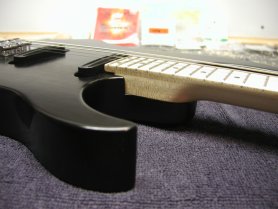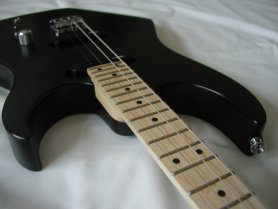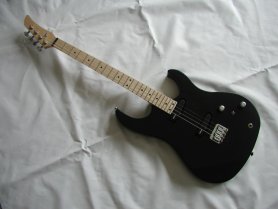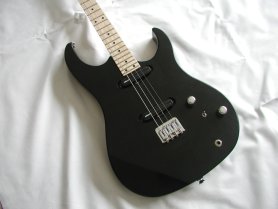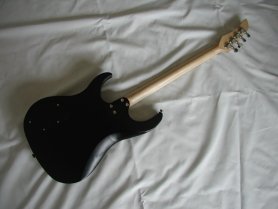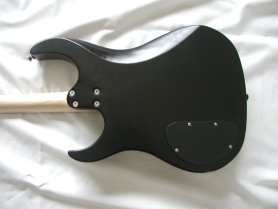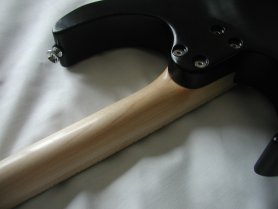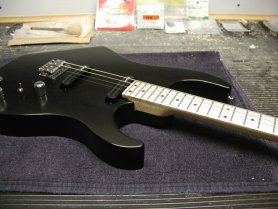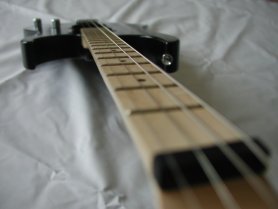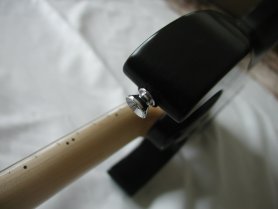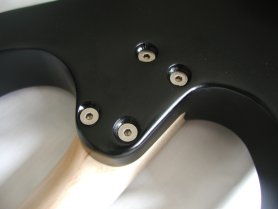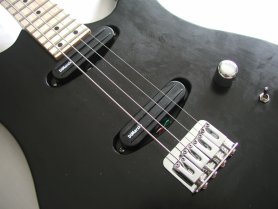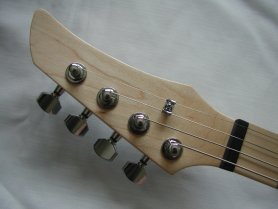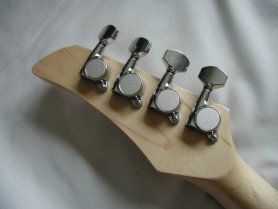Finished
Final Setup
Since I had already done a preliminary setup to test everything out, the final setup was fairly straight forward. After reattaching all the hardware, I strung up the mandolin so I could test and adjust the intonation. I also adjusted the pickups so the top of the rails would be about 3/16ths below the strings. To test the intonation I played the string with the 12th fret depressed and then the harmonic at the twelfth fret. If the fretted note was flat, I moved the saddle closer to the neck and vice-versa. The individual adjustability of these saddles made for very simple and accurate intonating compared with the incredibly labor intensive handmade wood bridge that I used on my other mandolins.
The Finished EOM
How it Sounds
Using the simple and inexpensive home recording program Garageband, Iíve been able to make all sorts of sounds using its digital modeling abilities; from insane overdriven tones to nice warm jazz sounds. Both pickups have plenty of power to create distortion ranging from classic rock to heavy rock. I havenít been able to get any truly face melting shred or metal guitar tones. This is likely due to the pickups lower output compared with full-size high-output humbuckers and limitations of the program. The two pickups give distinctly different tones while the tone knob allows any sound from muted to full treble. I still havenít had a chance to try the EOM through a real guitar amp or pedal rig.
How it Plays
The EOM feels a lot like an electric guitar, although itís noticeably smaller. The neck is much narrower which makes it easier to reach all four strings without much effort. Itís fairly comfortable to play when seated save for a few awkward positions. For example, when playing a barre chord near the nut, you have to lean down and drop your elbow to make it comfortable for your wrist, but I assume this is also a problem with an electric guitar. Itís very rewarding to play. It can do many things that guitars can but the 14 inch scale mandolins I have canít. Hammer-ons and pull-offs sound good and are easy to accomplish. Half step bends are very easy but whole step bends are a lot more difficult. This is probably due to the shorter string length of the EOM compared with a guitar. Iím also using heavier strings than I would like. When doing extreme bends, especially near the nut, the nut tends to move since it isnít glued in place. I was thinking of possibly gluing, pegging or screwing the nut in place to fix the problem. The EOM is surprisingly well balanced when played with a strap.
EOM vs. Guitar
Since Iíve spent very little time playing the guitar, itís hard to tell whatís easier and whatís more difficult about playing the EOM. In general, it should be easier to play some things on EOM and other things on a guitar while some things will just be different. Take the ubiquitous power chord: The chord shape on the EOM (for example, in tab, 331x) is exactly opposite that on a guitar in standard tuning (for example, in tab, 577xxx.) This does make it a little harder to dampen the unused string with your index finger because of the different position. But once you get used to playing a power chord on the EOM it should be just about as easy to play as on a guitar.
A major technical difference between the instruments is that the EOM requires fewer string changes, but more shifting up and down the neck and greater hand stretches. This can be frustrating as it takes more forethought to play something even as simple as a scale compared with when you can play more notes in one position. On the plus side, it will reduce the number of string skips and more complicated picking patterns over more strings that are necessary to play the same notes.
The most frustrating part about playing guitar parts on EOM is having to convert guitar tabs to EOM tabs by hand. This is easier than figuring out parts by ear, but it would be nice to be able to use the huge archives of tabbed parts for guitars that are already online.
Even with the larger set of strings I chose, the EOM doesnít seem to like being detuned all the way down to E (with the other strings still tuned in fifths up from E.) The strings would probably need to be even heavier to get the necessary tension at this EOMís much shorter scale length compared to a guitar (about three inches shorter.) Not being able to tune to E makes it even harder to play guitar parts in the original key. If there is a low E, F, or #F in the original part (low Eís are especially common in heavy rock and metal) you have to change the key to be able to play in the same octave as the original or shift the part up an octave. There are even more problems when transposing guitar parts written in drop-tunings.
